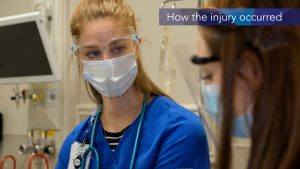Video developed to strengthen trauma care
As the system that cares for more injured children than any other in Minnesota, Children’s Minnesota is responsible for delivering the most specialized care for pediatric trauma patients. That responsibility requires ongoing, high-quality education.
In 2021, experts in nursing, trauma care and communications developed an educational video focused on pediatric trauma assessment in the acute care setting. Constructive feedback from staff on existing education materials, the evolution of trauma care on both Children’s Minnesota hospital campuses, the ongoing trauma education needs for inpatient staff and the release of new education requirements by the Minnesota Department of Health for Level 4 trauma centers all uncovered a need for this new educational content.
Nursing trauma experts, Mariya Bowen, DNP, CPNP-AC/PC; Erin Janushka, BAN, RN, CPN; and Sara Wiplinger, MN, RN, CCRN-K, led this collaborative project with marketing and communications, trauma services, and the Center for Professional Development and Practice. The team developed an educational video that demonstrates key considerations in assessing a patient with traumatic injury while highlighting the continuum of care for children including integration of social work, chaplaincy and child life services. Additionally, the video is shorter, more engaging, easily trackable and available through Self-Service, and more targeted to nurses at the bedside.
Nursing trauma experts collaborated with Chris Phillips, visual marketing consultant, to develop a script, identify actors and record the various components of the assessment of a trauma patient in the acute care setting. Recording was completed in the simulation lab at the Children’s Business Center. Several family members of Children’s Minnesota staff were included as actors, and care was taken to ensure all actors were representative of the diverse patient population that Children’s Minnesota serves.
This educational recording is now available on Children’s Minnesota’s intranet. To date, more than 100 nurses have viewed the recording and it is used for onboarding nurses in units that will care for injured children.



